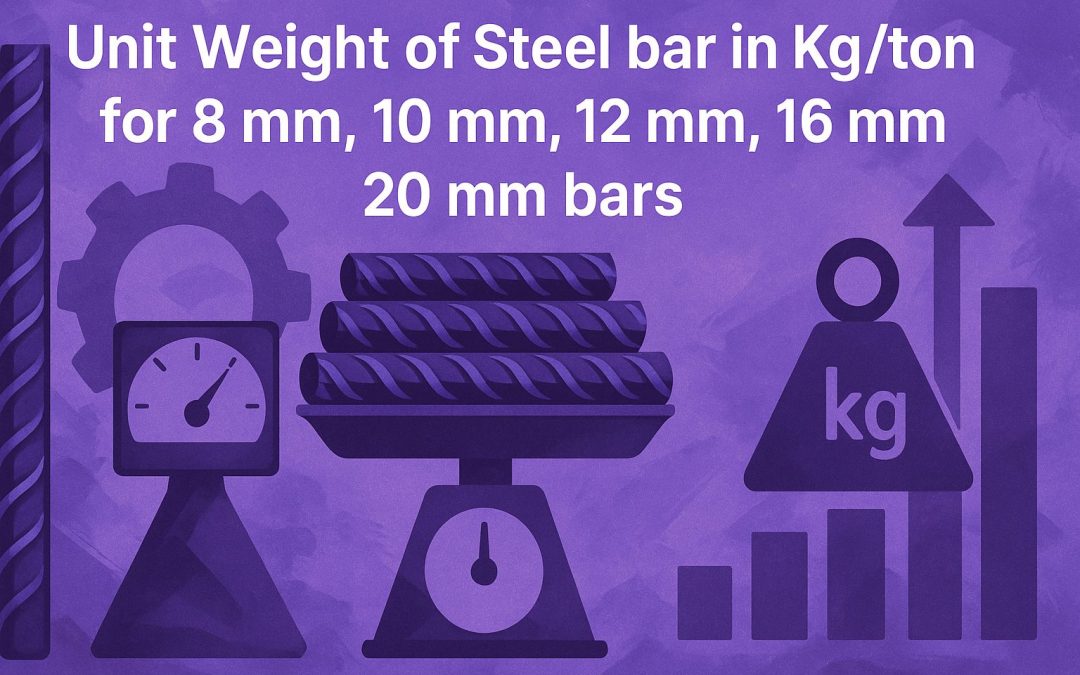Table of contents:
Steel bars are a common element in construction and manufacturing projects. Strong and versatile, these bars come in various types such as TMT bars, Mild Steel bars, deformed bars, steel rebars, reinforced bars, each with its unique properties and applications.
Understanding the weight of steel bars, therefore, is crucial for project planning, budgeting, and procurement. Referring to a steel bar weight chart, therefore, can be an invaluable reference tool.
Further, for industry professionals, knowledge of steel bar weight in kg enables resource allocation and cost estimation. Here, let us take a look at how to calculate the unit weight of steel bars and what a steel bar weight chart looks like.
Disclaimer: The focus here is to understand the process of steel bar weight calculations and how to prepare a weight chart for reference. The dimensions used below are for reference only. All should consult with their steel manufacturer for exact dimensions and sizes for the weight calculation.
Steel Bar Weight Chart
Before we learn how to calculate the unit weight of steel bars, let’s take a look at the steel bars weight chart in kgs for TMT bars, MS bars, deformed bars, and more.
TMT Bar Weight Chart
(Updated: July 2025 | All weights in kg, length = 12m)
| Diameter (mm) | Weight of a single bar (12m) | Number of bars in a bundle | Unit weight per metre (kg/m) | Number of bars in a ton | Approx Price (₹/kg) |
| 8 | 4.74 | 10 | 0.395 | 211 | ₹47.9 |
| 10 | 7.41 | 10 | 0.617 | 135 | ₹47.9 |
| 12 | 10.67 | 10 | 0.889 | 93 | ₹47.9 |
| 16 | 18.96 | 5 | 1.580 | 52 | ₹46.8 |
| 20 | 29.63 | 5 | 2.469 | 34 | ₹46.8 |
| 25 | 46.30 | 2 | 3.858 | 22 | ₹55.5 |
| 32 | 75.85 | 2 | 6.321 | 13 | ₹55.5 |
| 36 | 96.00 | 1 | 8.000 | 10 | ₹55.5 |
*For reference only. Please check with your steel seller for precise size, price, weight, and other details.
MS Round Bars Weight Chart
Weight Chart with Approximate Price (July 2025)
| Size (mm) | Weight (kg/ft) | Weight (kg/m) | Approx. Price (₹/kg) |
| 8 mm | 0.129 | 0.395 | ₹46 |
| 10 mm | 0.188 | 0.617 | ₹46 |
| 12 mm | 0.270 | 0.888 | ₹46 |
| 14 mm | 0.369 | 1.210 | ₹45.5 |
| 16 mm | 0.480 | 1.580 | ₹45 |
| 20 mm | 0.752 | 2.469 | ₹45 |
*For reference only. Please check with your steel seller for precise size, price, weight, and other details.
Deformed Reinforcing Steel Bars Weight Chart
Weight Chart with Approximate Price (July 2025)
| Size (mm) | Weight (kg/ft) | Weight (kg/m) | Approx. Price (₹/kg) |
| 8 mm | 0.120 | 0.395 | ₹47.9 |
| 10 mm | 0.188 | 0.617 | ₹47.9 |
| 12 mm | 0.271 | 0.888 | ₹47.9 |
| 14 mm | 0.369 | 1.210 | ₹47.9 |
| 16 mm | 0.481 | 1.580 | ₹46.8 |
| 20 mm | 0.753 | 2.469 | ₹46.8 |
| 25 mm | 1.176 | 3.858 | ₹55.5 |
| 28 mm | 1.473 | 4.832 | ₹55.5 |
| 32 mm | 1.930 | 6.321 | ₹55.5 |
| 36 mm | 2.444 | 8.000 | ₹55.5 |
| 40 mm | 3.001 | 9.870 | ₹55.5 |
*For reference only. Please check with your steel seller for precise size, price, weight, and other details.
Hot-Rolled Steel Bars Weight Chart
Weight Chart with Approximate Price (July 2025)
| Size | Diameter (mm) | Weight (kg/m) | Diameter (D, mm) | Weight (kg/m) | Weight (kg/mm) | Diameter (D, mm) | Weight (kg/mm) | Approx. Price (₹/m) |
| 8 mm | 30 | 0.40 | 90 | 5.55 | 49.95 | 190 | 222.60 | ₹21 |
| 10 mm | 32 | 0.62 | 95 | 6.30 | 55.64 | 200 | 246.60 | ₹32 |
| 12 mm | 39 | 0.90 | 105 | 8.90 | 69.70 | 220 | 299.30 | ₹47 |
| 14 mm | 42 | 1.20 | 115 | 10.90 | 81.55 | 235 | 340.00 | ₹62 |
| 16 mm | 48 | 1.60 | 125 | 14.20 | 97.34 | 250 | 386.15 | ₹78 |
| 20 mm | 65 | 2.47 | 145 | 26.05 | 130.11 | 290 | 520.00 | ₹96 |
*For reference only. Please check with your steel seller for precise size, price, weight, and other details.
What is the Unit Weight of Steel Bars?
What is the unit weight of a steel bar, and what does it mean?
The unit weight of a bar is the weight per unit length of the bar. Therefore, the unit weight of a steel bar is the weight per unit length of the steel bar.
In other words, it is the ratio of the unit weight of the steel bar to its unit volume. The unit of this ratio is kg/m. This defines the weight of the steel bars formula as well.
Why is unit weight calculation important?
Load bearing, stability, and durability are important functions of the steel bars used in construction. Steel unit weight calculation is therefore important as it enables engineers to estimate how much or how many steel bars are required to fulfil the load-bearing capacity requirements and give the building its structural integrity.
It also helps businesses prevent the waste of raw materials.
How to calculate the Unit Weight of Steel Bars?
Steel bars can be of a circular or rectangular cross-section. We will examine how to calculate the unit weight of steel round bars with a circular cross-section, as these are the most widely used.
The formula for calculating the unit weight is:
Weight = Volume x Density
- Volume: For steel bars, volume is derived from their length (L) and cross-sectional area (A)
- Cross-sectional area of the bar: Calculated as πr² (where ‘r’ is the radius and is half the diameter)
- Density: 7850 kg/m³ (this figure is standard for calculations)
So, the full formula becomes:
Weight = (π × D² / 4) × L × 7850 × 10⁻⁶
Steps to calculate the unit weight of steel bars
Let’s look at a simple example to understand how to find the weight of a steel bar.
Step 1: Know the dimensions
Steel TMT bars come in standard diameters like 8 mm, 10 mm, 12 mm, 16 mm, etc.
Here, the diameter is the end-to-end measurement of the circular face of the bar.
In this example, we’ll use:
- Length = 10 m
- Diameter = 12 mm
- Radius = 6 mm or 0.006 m (half the diameter)
Step 2: Calculate the cross-sectional area
Use the formula:
Area = πr²
= 3.1416 × (0.006)²
= 0.000113 m²
Step 3: Find the volume per meter
Volume = Area × Length
= 0.000113 × 10
= 0.00113 m³
Step 4: Calculate the total weight of the bar
Weight = Volume × Density
= 0.00113 × 7850
= 8.87 kg
So, a 12 mm steel bar of 10 m length weighs approximately 8.87 kg.
Unit Steel Bar Weight Chart sample with Approx. Price (July 2025)
Based on the formula above, here’s a sample weight chart for steel bars of 12-meter length and 8-meter length.
Pricing Formula Used: Approx. Price = Weight (kg)×₹47.9
Unit Weight and Approx Price for 12mm Steel Bar
| Radius | Unit weight in kg | Approx. Price |
| 4 mm | 4.74 kg | ₹227.45 |
| 5 mm | 7.40 kg | ₹354.46 |
| 6 mm | 10.65 kg | ₹510.54 |
| 8 mm | 18.94 kg | ₹907.63 |
| 10 mm | 29.59 kg | ₹1,416.44 |
| 11 mm | 35.81 kg | ₹1,714.35 |
| 12.5 mm | 46.24 kg | ₹2,215.90 |
| 16 mm | 75.76 kg | ₹3,627.89 |
*For reference and information only. Not exact. Please check with your steel manufacturer for actual dimensions and weight.
Grades and Sizes of Steel Bars as per Indian Standard Code
Given below are the nominal size groups of steel bars and steel wires, and their grades according to the Indian Standard code:
Table 1: Grouping of Steel Bars Based on Nominal Diameter (IS 1786:2008)
| Group | Size |
| Group I | 4 mm, 5 mm, 6 mm |
| Group II | 8 mm, 10 mm, 12 mm, 16 mm, 20 mm, 25 mm, 28 mm, 32 mm |
| Group III | 36 mm, 40 mm, 45 mm, and 50 mm |
Table 2: Grouping of Steel Bars Based on Strength Grade (IS 1786:2008)
| Group | Strength grade |
| Group 1 | Fe 415, Fe 415D, Fe 415S |
| Group 2 | Fe 500, Fe 500D, Fe 500S |
| Group 3 | Fe 550, Fe 550D |
| Group 4 | Fe 600 |
| Group 5 | Fe 650 |
| Group 6 | Fe 700 |
*Source: https://bis.gov.in/wp-content/uploads/2020/07/PM-IS-1786-JULY-2020-Revised-4.pdf
The weight of steel is generally measured in kilograms or tonnes. Construction projects usually source tonnes of steel bars as raw materials. Measuring the unit weight of steel bars is necessary to determine the load-bearing capacity of pillars, columns, etc.
Steel Bar Applications
Steel bars, particularly TMT bars, are the foundation of modern construction. Depending on their strength, ductility, and corrosion resistance, they are found in various forms, sizes, and applications throughout the industry. Here is where, and how, steel bars are typically used:
- Buildings (residential and commercial): TMT bars are generally used to reinforce concrete beams, slabs, columns, and foundations. They hold buildings together in high-load scenarios, thermal changes, and earthquakes. Fe 500D and Fe 550D are two TSN commonly used in seismic zones due to their flexibility.
- Bridges and flyovers: Bridges are subjected to dynamic loads and aggressive environmental conditions. Fe 600 and 700 high-strength steel bars offer high tensile strength and corrosion resistance, which are necessary to withstand longer spans of heavy loads in high-traffic conditions.
- Roads: Steel bars are used in pavements, as well as retaining walls, in order to add structural strength. In highway structures, steel bars help to increase load-bearing capacity and reduce long-term maintenance requirements.
- Dams and Water Retaining Structures: In dams, water tanks, and sewage systems, it is common to use steel bars to resist cracking as a result of the applied water pressures. The bonding strength of steel bars with concrete is even greater when a significant amount of moisture is present.
- Industrial and Power Plants: Steel bars used in large-scale structures, such as factories, lots, and generating stations, are to be able to withstand large temperature changes and heavy mechanical loads. Steel bars create the load-bearing structure for columns, machinery beds, and high-load areas.
Disclaimer: *This article is for information sharing only. The weight calculation process explained is for readers to understand how steel bars are weighted. Dimensions are for reference. Please consult with your steel supplier for exact dimensions, sizes, weight, and other details.
Looking to procure steel?
Tata nexarc helps manufacturers, builders and MSMEs source certified steel products, compare prices, and choose the right grade as per IS codes—with complete traceability and procurement confidence.
FAQs
How heavy is a 12 mm TMT bar per meter?
How many 8 mm TMT bars make one ton?
What are the size groups of steel bars under IS 1786?
Which strength grades of TMT bars are available in India?
Is BIS certification compulsory for TMT bars in 2025?
Which TMT grade is best for residential buildings?
What density of steel should I use for weight calculations?
What is the meaning of the unit weight of TMT bar?
What is the formula for steel weight calculation?
| Steel Type | Weight Formula | Example Dimensions | Approx. Weight |
| TMT Bars | π × r² × L × 7850 | L = 12 m, r = 6 mm (0.006 m) | ≈ 10.6 kg |
| Steel Beams | L × W × H × 7850 | L = 6 m, W = 0.1 m, H = 0.2 m | 942 kg |
| Steel Sheets | L × W × Thickness × 7850 | L = 2 m, W = 1 m, T = 0.002 m | 31.4 kg |
| Steel Pipes/Tubes | π × (R² − r²) × L × 7850 | L = 3 m, R = 0.05 m, r = 0.045 m | ≈ 20.3 kg |
What is the difference between Fe 500 and Fe 500D?
Sohini is a seasoned content writer with 12 years’ experience in developing marketing and business content across multiple formats. At Tata nexarc, she leverages her skills in crafting curated content on the Indian MSME sector, steel procurement, and logistics. In her personal time, she enjoys reading fiction and being up-to-date on trends in digital marketing and the Indian business ecosystem.








Having a weight chart available is helpful for estimating material needs and costs during project planning. The comparison of TMT, MS round, deformed reinforcing, and hot-rolled steel bars is really useful. Would like to know if there are standard length options available for each bar diameter.
aniketkumarak1272454@gmail.com
I’m building a small residential house. What type and size of steel bar would typically be recommended for the foundation and the walls?
Where you’re based? I have construction company from Rohtak. You can use TMT bars for foundation and steel as they are very strong. Generally, TMT bars with diameters of 10mm, 12mm, or 16mm are used for foundations. I can give you contact of structural engineer who can help you with this.
This chart is helpful. taken a print of this and kept on my desk under the glass 🙂
Calculating steel bar weight is now easy for me. Also creating an excel format for my team which can use it on day to day basis.
For anyone involved in construction or manufacturing, having a reference like this is crucial for accurate material planning and cost estimation. The detailed breakdown of different steel bar sizes and their corresponding weights helps streamline the procurement process, ensuring that there’s no overestimation or underestimation of the materials required.
Much appreciated for this weight chart and formula.
I stand with you bro
During procurement, this is very important for everyone. I have experienced that Weight Calculation of TMT bars and steel products set base for the negotiation on the price also. Higher quantity and higher weight will bring the per kg cost down.
Yes it sets a base for negotiation. But this weight chart will always help in pre-plan procurement and will give you a tentative idea of amount required for order placement.
Understanding the weight of steel bars is essential for effective project planning and budgeting in construction. Different types, like TMT and deformed bars, serve unique purposes, making a weight chart a vital tool for professionals. Knowing how to calculate unit weight aids in resource allocation and cost estimation, ensuring projects run smoothly and efficiently.
This is extremely useful. I have been trying to solve this for days until I stumbled on this page. Thank you so much.